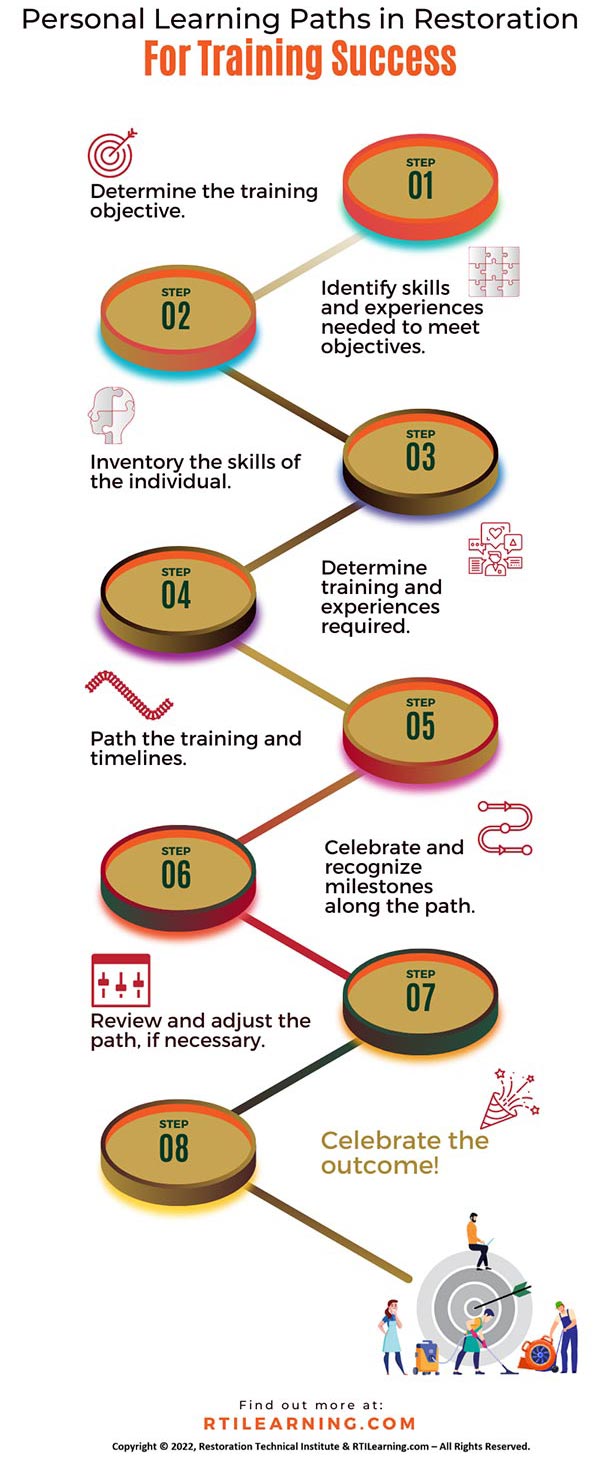Hiring outside the industry brings fresh ideas to your organization. It is a necessity for overcoming labor shortages and has many other advantages like avoiding the need to overcome bad habits that sometimes come with experience. You have a clean slate to train. So, now what?
Over the years, I have been asked the how and what of training a new person. I know everyone who has asked this question wants an easy answer like, “Send them to water restoration technician (WRT) training and then send them to ‘X’.” My answer typically involves me walking them through a simple series of questions.
Training a new person for success is not quite as simple as we may want. However, it can be simplified. When approached deliberately and applied consistently, setting up a new hire for success can be done and produce desired outcomes for both the company and employee. The first tip is that it should be a part of a developed on onboarding program. Are you on board with employee onboarding?
Next, I present the idea of a personalized learning path. In the context of the workplace, it is best defined as the “Learning Paths Methodology,” which, since 1993, has been applied as an employee training approach. It is touted as reducing time to proficiency by more than 30% in every case, across employees of diverse roles. As Learning Paths International explains, “A Learning Path is the series of learning activities that go from day one to proficiency. These activities include formal training, practice, experience and more.” The three principles of the employee training methodology include: 1) Learning as a process – not an event – extending beyond the classroom, 2) Knowing and doing are different things, 3) Training should be by design rather than by accident.
Learning paths provide a transparent and deliberate approach to the training process. At Restoration Technical Institute (RTI), the concept is a cornerstone to how we help companies with their training programs. Identifying gaps and needs helps individuals and companies achieve their goals. It is a basis for our development of curriculum so that needed resources are available and accessible. You can learn more about learning paths and other training technology at Learning Today with RTILearning.com.
Steps to Develop Personal Learning Paths for Training Success
-
Determine the training objective. What is the desired outcome? You can approach this a few different ways. As you build the plan, keep in mind the complexity of the path will be based on the individual, their capabilities and limitations, as well as the desired outcome. Examples:
- By task: Fire structure clean, extract water
- By key function: Run a water loss, schedule coordination
- By job title: Project manager, lead technician
-
Identify skills and experiences needed to meet objectives. It will be challenging to develop an effective training path if there is no clarity regarding the skills and experiences required for the objective. In “A New Tech Under Your Wing,” one of the tips calls for the use of a training guide or matrix. The matrix will allow you and your team to consistently apply a specific set of desired skills and proficiencies. It can also be a tool for the trainee to engage and have clarity on the requirements.
Be sure to capture all the training necessary: Technical skills, soft skills, computer, software, equipment, products, safety and other specific company processes, etc. A brief example for a lead technician may have these elements:
- Perform the following on water losses > 5,000 square feet
- Calculate equipment and layout drying plan
- Map and monitor
- Remove baseboard, cove base, insulation, drywall
- Set up equipment
- Lead and supervise a crew of up to five people
- Proficiency in using company software
- Ability to communicate progress, changes and meaningful information to property owners
- Completed on-the-job training by successfully engaging in:
- Clearly defined experiences
- Use of equipment/products/other
- Account for company-specific training requirements that may include but are not limited to:
- Standard operating procedures
- Software and systems
- Formal and informal processes
- Perform the following on water losses > 5,000 square feet
- Inventory the skills of the individual. An inventory of the skills and capabilities the individual has may be determined by a combination of the following: Previous job experiences, credentials/certifications/degrees, assessment testing, skillful interviewing, etc.
- Determine the training and experiences required. This can be viewed as a mathematical equation: Skills needed – skills present = training needed. An example of this may be an estimator from outside the industry who came to you with experience equivalent to the skills needed in sketching a building. Sketching may be a skill required for the position of the estimator, and this was accounted for in the individual’s inventory.
- Path the training and timelines. Now that we know what the training needs are, we can lay them out, correlate timelines, and facilitate a path based on the individual and the criteria established.
- Celebrate and recognize the milestones along the path. A learning culture and engaging the new person on their training journey is of great importance. It encourages everyone to celebrate and support each other’s learning and growth.
- Review and adjust the path, if necessary. The idea is to make this personalized for the learner while meeting all company objectives. As an example, you may have pathed a water technician to learn to extract > set equipment > monitor > basic demo. As the learner progresses, you may notice that the monitoring and math may not be the best next training step after learning to set equipment. You then adjust and change the path to basic demo.
- Celebrate the outcome! Following a basic system of training in your company will help you achieve consistency and positive results.

As you develop your systems to train people from outside or inside the industry, the learning path method will bring you success. The following is a short list of some of the things needed to help you effectively and efficiently deploy:
- Budget: Training is an investment in our most valued asset, our people.
- Assignment of responsibility: The company must support the responsibility of managing, deploying and pathing the team’s learning initiatives.
- Apprenticeship and team: Have a defined expectation and the tools to measure the outcomes of field training. Other team members should be engaged in applying a consistent and positive approach to on-the-job training.
- Resources and tools: Like everything else in this industry, there is a constant evolution of technology and resources. This makes the delivery and management of training easier than ever before. According to an article in Small Business Trends, 98% of planned to use eLearning by 2020.


